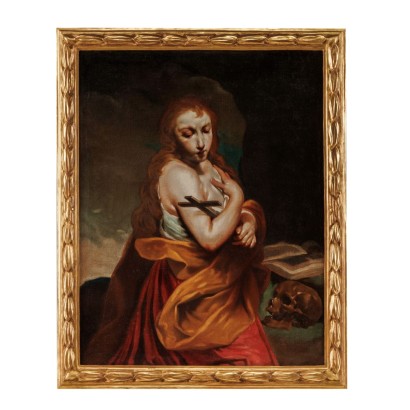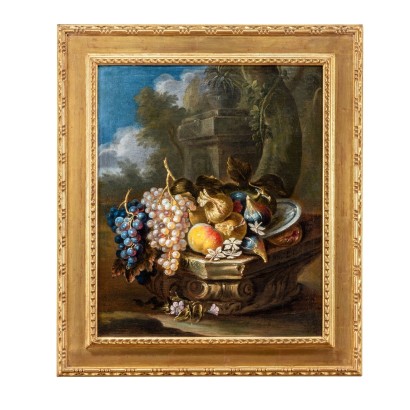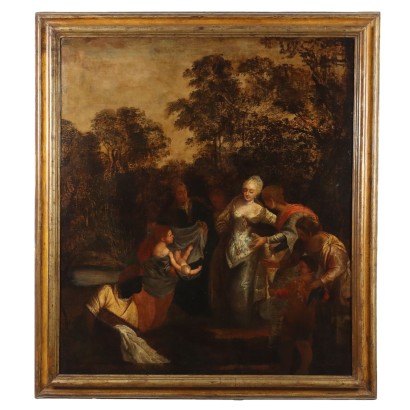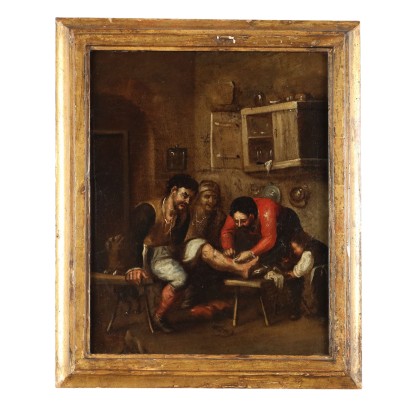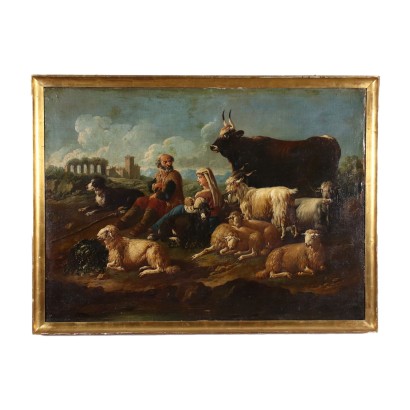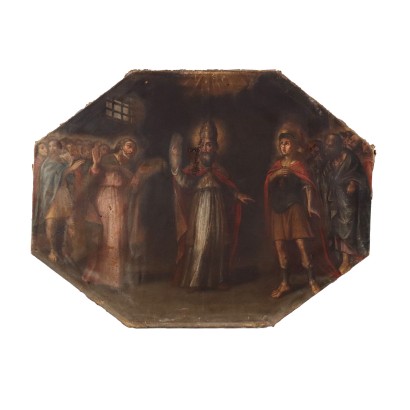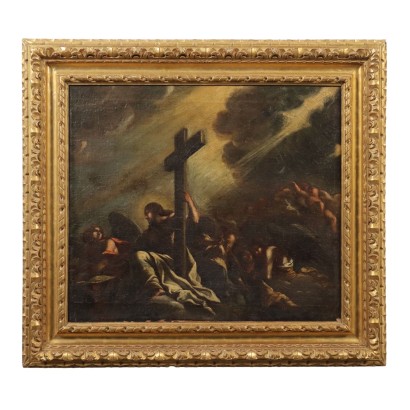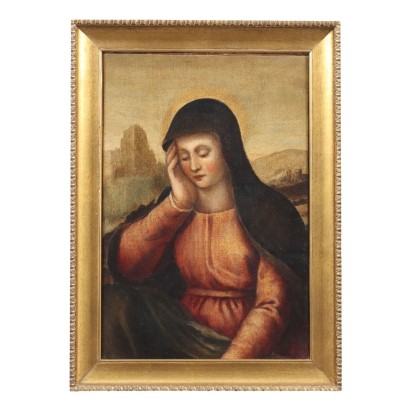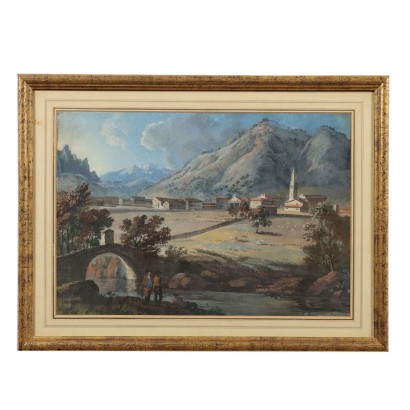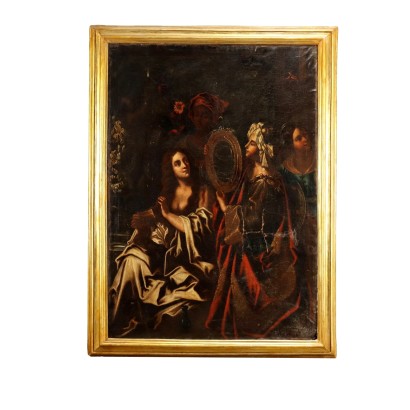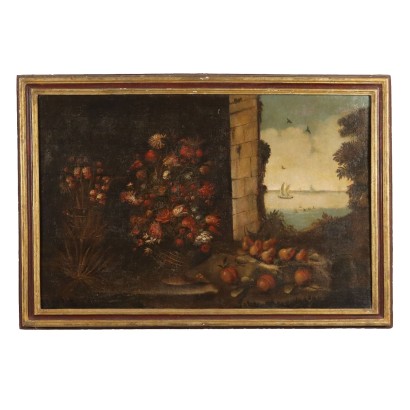Antique Painting Religious Subject Oil on Canvas 1750 ca. - Penitent Magdalene, ca. 1750
Features
Penitent Magdalene, ca. 1750
Artist: Giuseppe Maria Crespi (1665-1747) Scope of
Artwork title: Maddalena penitente
Age: 18th Century / 1701 - 1800
Subject: Figures of Saints
Origin: Italy
Artistic technique: Painting
Technical specification: Oil on Canvas
Description : Maddalena penitente
Oil on canvas. The figure of Mary Magdalene is represented here, as per tradition, with long red hair; with a gesture of painful dedication she fixes her gaze on the crucifix, which she holds with her left hand pressed against her right arm, which in turn is folded in a sign of collected penitence. The whole body is rendered with a splendid counter-twist, which has the effect of making the viewer feel the tension of the moment experienced by the saint. On her left is visible the skull, her traditional attribute, and in the background one can glimpse the outline of the cave in which she is placed. The part of the body emerges, thanks to the intense luminosity of the arms, connected to the red ochre shades of the hair and face, thus also accentuating the erotic character of the scene, recalling the exuberant painting of Rubens, which had a great influence on Crespi's work. This captivating and delightful figure of the Magdalene follows the widespread trend in the 17th and 18th centuries to depict saints with an undertone of human sensuality, revealing the patrons' preference for sacred themes imbued with profane elements. The painting, restored and relined, is presented in a late 19th-early 20th century frame.
Product Condition:
Product in good condition, shows small signs of wear. We try to present the real condition as completely as possible with the photos. If some details are not clear from the photos, what is reported in the description is valid.
Frame Size (cm):
Height: 111
Width: 89
Depth: 6
Artwork dimensions (cm):
Height: 96
Width: 75
Additional Information
Notes historical bibliographic
The present painting, which can be dated to around the mid-18th century, is derived from the original versions by Crespi, a very active painter of Bolognese origins, of whom at least two versions are known. The first, preserved in the art gallery of Bologna, already coming from the Florentine Loeser collection, then acquired by an English private individual, was purchased by the art gallery in 1996. The second, closer to ours in the design of the details, was part of Angelo Cecconi's collection in Florence , then acquired in 1947 in the Briganti collection, then passed into a private collection in Como, was auctioned at Dorotheum in 2018. Giuseppe Maria Crespi, known as Lo Spagnuolo, was a tireless and prolific artist, totally dedicated to his pictorial activity; At least 300 works are certainly his, already documented years ago by Mira Merriman. A first detailed account of his life was left to us by Abbot Giampietro Zanotti in his "History of the Accademia Clementina" printed in Bologna in 1739, and then other information comes to us from the writings of his son Luigi, also a painter. From their stories it emerges that Crespi surrounded himself with a notable number of young painters, whom he had in his workshop, together with his three painter sons, Luigi, Ferdinando and Antonio Liborio. To everyone, thanks to his experience, he never stopped recommending the exercise of copying "this is why he continually exhorted his students to imbibe the ways of great men, to then have them present to their imagination when they worked: here finally, the how he trained in his own way." If in the present painting there are no elements to glimpse direct interventions by the master, its high pictorial quality, combined with some details of luminous rendering, and the measurements identical to the two original versions by Crespi, can lead us to hypothesize that it is a copy performed precisely in his context, by some of his students or children.Artist: Giuseppe Maria Crespi (1665-1747)
Born in Bologna in 1665, Giuseppe Maria Crespi, nicknamed from a young age "lo Spagnolo" or "lo Spagnoletto" for his habit of wearing tight-fitting Spanish-style clothes, received his first training from the painter A.M. Toni and then moved on to the school of Canuti and, later, attended the Accademia del nudo at Cignani's atelier. Then, financed by the rich Bolognese patron Giovanni Ricci, he completed the second part of his training by studying, around northern Italy, the great works of the Emilian school of the late Renaissance (Correggio, Federico Barocci) and coming into contact with the Venetian colorism that would particularly influence him. A very versatile painter in the choice of the episodes represented, he explored all painting, from sacred to genre painting to portraiture, creating original works, in full recovery of some elements of popular naturalism. Between 1700 and 1705 Crespi worked for Eugene of Savoy. His patron was Prince Ferdinando de' Medici, for whom he executed some of his best works, including Fiera di Poggio a Caiano, Massacre of the Innocents (Uffizi) and an Ecstasy of Saint Margaret (Diocesan Museum of Cortona). He collaborated actively with the Accademia Clementina in Bologna and later received a commission from an English merchant, for whom he executed a cycle that deals with the Life of an Opera Singer, which has not reached us, except for the Flea Hunter, where the poverty and anti-heroicism of the episode and the character are clearly visible, as had been seen in his previous works. In 1740 he was knighted by Pope Benedict XIV. In 1745 he lost his sight without being able to paint anymore and died in 1747.Age: 18th Century / 1701 - 1800
18th Century / 1701 - 1800Subject: Figures of Saints
Artistic technique: Painting
La pittura è l'arte che consiste nell'applicare dei pigmenti a un supporto come la carta, la tela, la seta, la ceramica, il legno, il vetro o un muro. Essendo i pigmenti essenzialmente solidi, è necessario utilizzare un legante, che li porti a uno stadio liquido, più fluido o più denso, e un collante, che permetta l'adesione duratura al supporto. Chi dipinge è detto pittore o pittrice. Il risultato è un'immagine che, a seconda delle intenzioni dell'autore, esprime la sua percezione del mondo o una libera associazione di forme o un qualsiasi altro significato, a seconda della sua creatività, del suo gusto estetico e di quello della società di cui fa parte.Technical specification: Oil on Canvas
The oil painting is a painting technique using powder pigments mixed with bases in inert and oils.Other customers have searched:
Pittura antica, artisti italiani, pittura olio su tela, arte 800, pittura antica, arte novecento, oggetti d'arte, ritratto di signora, dipinto animali, quadro paesaggio montano, dipinto olio su tela, dipinto antico, dipinti natura morta, quadro antico, quadro del '600, pittori italiani quadri olio su tela paesaggi, paesaggio marino dipinto, paesaggio invernale dipinto, paesaggio autunnale dipinto, dipinto di paesaggio, arte antica, quadro religioso..
Se sei un appassionato d'arte, non perderti i nostri approfondimenti sul Blog Arte Di Mano in Mano e su FineArt by Di Mano in Mano - Arte:
Leggi di più
Ecco alcuni tra i principali articoli:
Vedute
Falsi nell'arte antica
Un messaggio di fiducia per ripartire
La potenza espressiva dell'arte figurativa etiope
Breve Storia del Collezionismo
Giorgio Upiglio, maestro dei libri d'artista
Matthias Withoos detto "Calzetta bianca"
San Rocco pensaci tu - Classic Monday
Dai un'occhiata alle nostre rubriche di divulgazione sull'arte:
Epoche
Lavorazioni e tecniche
Mostre ed Eventi
Protagonisti
Se sei appassionato di pittura antica, con tutta probabilità gusterai le schede di questi stupendi quadri:
"Dio parla a Noè dopo il diluvio", Jacopo da Ponte, detto il Bassano, seconda metà XVI secolo
Crocifissione, maestro della misericordia dell'accademia, terzo quarto del XIV secolo
Erminia incontra i pastori, Camillo Gavassetti, Seconda metà anni Venti del XVII Secolo
Eroine dell'antichità, Francesco Conti, XVIII secolo
Hieronymus III Francken, La Negazione di Pietro, XVII secolo
Jefte e la figlia, Girolamo Forabosco e aiuti, XVII secolo
L'Accademia di Platone, piccolo arazzo, fine XVII - inizio XVIII secolo
Maddalena e San Giovanni Battista
Natura Morta, Bartolomeo Arbotori, XVIII secolo
Sacra Famiglia con San Giovannino, Bartolomeo Ramenghi, scuola di, prima metà XVI secolo
Testa Femminile, Andrea del Sarto, ambito di, post 1522
Uva, fichi, melagrana e pesche su un capitello - Maximilian Pfeiler, primo quarto XVIII secolo
Sapevi che l'arte può essere anche un ottimo investimento (e non solo per grandi portafogli)?
L'Arte tra Collezionismo e Investimento
FineArt: Arte come investimento
Leggi di più
Ecco alcuni tra i principali articoli:Vedute
Falsi nell'arte antica
Un messaggio di fiducia per ripartire
La potenza espressiva dell'arte figurativa etiope
Breve Storia del Collezionismo
Giorgio Upiglio, maestro dei libri d'artista
Matthias Withoos detto "Calzetta bianca"
San Rocco pensaci tu - Classic Monday
Dai un'occhiata alle nostre rubriche di divulgazione sull'arte:
Epoche
Lavorazioni e tecniche
Mostre ed Eventi
Protagonisti
Se sei appassionato di pittura antica, con tutta probabilità gusterai le schede di questi stupendi quadri:
"Dio parla a Noè dopo il diluvio", Jacopo da Ponte, detto il Bassano, seconda metà XVI secolo
Crocifissione, maestro della misericordia dell'accademia, terzo quarto del XIV secolo
Erminia incontra i pastori, Camillo Gavassetti, Seconda metà anni Venti del XVII Secolo
Eroine dell'antichità, Francesco Conti, XVIII secolo
Hieronymus III Francken, La Negazione di Pietro, XVII secolo
Jefte e la figlia, Girolamo Forabosco e aiuti, XVII secolo
L'Accademia di Platone, piccolo arazzo, fine XVII - inizio XVIII secolo
Maddalena e San Giovanni Battista
Natura Morta, Bartolomeo Arbotori, XVIII secolo
Sacra Famiglia con San Giovannino, Bartolomeo Ramenghi, scuola di, prima metà XVI secolo
Testa Femminile, Andrea del Sarto, ambito di, post 1522
Uva, fichi, melagrana e pesche su un capitello - Maximilian Pfeiler, primo quarto XVIII secolo
Sapevi che l'arte può essere anche un ottimo investimento (e non solo per grandi portafogli)?
L'Arte tra Collezionismo e Investimento
FineArt: Arte come investimento
Product availability
The product can be seen at Cambiago
Immediate availability
Ready for delivery within 2 working days from ordering the product.



